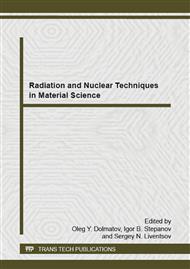[1]
V.I. Chernov, I.G. Sinilkin, S.V. Shiryaev, Radionuclide detection of sentinel lymph nodes, in: Yu.B. Lishmanova, V.I. Chernova (Eds. ), National guidelines for radionuclide diagnosis (Natsional'noe rukovodstvo po radionuklidnoi diagnostike), STT Publishing, Tomsk, 2010, pp.336-343.
Google Scholar
[2]
P. Paredes, S. Vidal-Sicart, G. Zanón, Clinical relevance of sentinel lymph node in the internal mammary chain in Breast cancer patients. Eur. J. Nucl. Med. 32(11) (2005) 1283-1287.
DOI: 10.1007/s00259-005-1867-z
Google Scholar
[3]
S.V. Kanaev, S.N. Novikov, L.A. Zhukova, O.V. Zotova, V.F. Semiglazov, P.V. Krivorot'ko, Lymphoscintigraphy of individual lymph flow for radiotherapy planning in breast cancer, Problems in Oncology (Voprosy onkologii, in Russian). 57(5) (2011).
Google Scholar
[4]
V.I. Chernov, S.G. Afanas'ev, A.A. Sinilkin, Radionuclide diagnosis for detection of sentinel lymph nodes, Siberian J. of Oncology (Sibirskii onkologicheskii zhurnal, in Russian). 28, 4 (2008) 5-10.
Google Scholar
[5]
A.J. Schauer, W. Becker, M. Reiser, K. Possinger, The Sentinel Lymph Node Concept, Springer, Berlin, (2005).
Google Scholar
[6]
S. Maza, Peritumoural versus subareolar administration of technetium-99m nanocolloid for sentinel lymph node detection in Breast cancer: preliminary results of a prospective intra-individual comparative study, Q. J. Nucl. Med. 30 (2003) 651-688.
DOI: 10.1007/s00259-003-1128-y
Google Scholar
[7]
A.V. Avgustinovich, V.I. Chernov, I.G. Sinilkin, Radio-guided sentinel lymph node detection in gastric cancer patients, Siberian J. of Oncology (Sibirskii onkologicheskii zhurnal, in Russian). 34 (4) (2009) 27-31.
Google Scholar
[8]
V.S. Skuridin, E.S. Stasyuk, V.N. Varlamova, A.S. Rogov, V.L. Sadkin, E.A. Nesterov. The research of ammonium hexafluorosilicate desublimation, Bulletin of the Tomsk Polytechnic University. Chemistry (Izvestiya TPU. Khimiya, in Russian) 323, 3 (2013).
Google Scholar
[9]
V.S. Skuridin, E.S. Stasyuk, N.V. Varlamova, P.S. Postnikov, E.A. Nesterov, V.L. Sadkin, Synthesis and experimental tests of labeled technetium-99m magnetically nanocolloid drugs on the basis of gamma-aluminum oxide and the magnetic particles of Fe@C(IDA, Russian Physics Journal (Izvestiya VUZov. Fizika, in Russian) 54 (11/2) (2011).
DOI: 10.4028/www.scientific.net/amr.1084.582
Google Scholar
[10]
R.U. Khabriev, Guidelines for experimental (preclinical) studying of new pharmacological substances, Moscow, 2005, рр. 729-735.
Google Scholar


